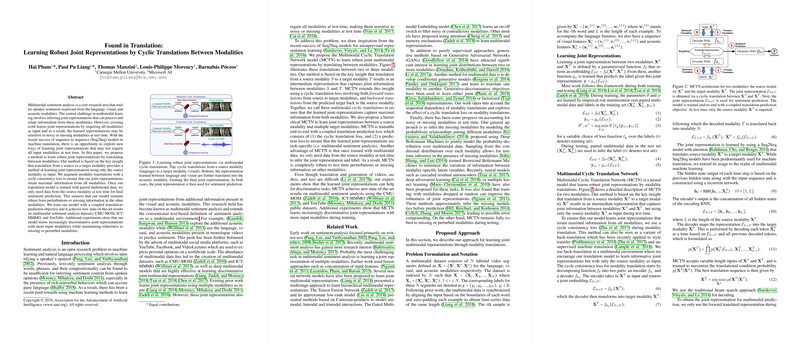An Essay on "Found in Translation: Learning Robust Joint Representations by Cyclic Translations Between Modalities"
The paper "Found in Translation: Learning Robust Joint Representations by Cyclic Translations Between Modalities," addresses the challenges in multimodal sentiment analysis by introducing an innovative method centered on cyclic translations between different data modalities. The objective of this research is to develop robust joint representations that remain effective even when some modalities are noisy or absent during testing. This work leverages the principles underpinning recent successes in Seq2Seq models from machine translation to analyze sentiment from language, visual, and acoustic inputs.
Central Contributions
The authors present a Multimodal Cyclic Translation Network (MCTN), a neural architecture that learns joint representations by translating between modalities. One of the prominent challenges tackled by the MCTN is the dependence on multiple modalities typically seen in existing joint representation models. The requirement for data from all modalities at test time can make these models vulnerable if any of the modalities are noisy or missing. The MCTN resolves this limitation by transforming the traditional approach: using cyclic translations allows the model to infer robust joint representations from a single source modality. The joint representation learned this way benefits from the multidimensional data during training but relies only on the source modality during inference.
Key Methodology
The MCTN operates on the insight that translating from a source to a target modality and subsequently using a cycle-consistency loss ensures that the representation captures information maximally from both modalities. This process of cyclic translation involves encoding data from a source modality, decoding it into a target modality, and then mapping it back, thus ensuring consistency and transference of information. This strategy is reflective of concepts from unsupervised learning, like back-translation, which have been applied in contexts such as style transfer and unsupervised machine translation.
The MCTN is trained with a coupled translation-prediction objective, which includes: (1) cyclic translation loss to retain maximum information, and (2) a prediction loss to ensure task relevance. After training on aligned multimodal data, it is possible to perform sentiment prediction using only data from the source modality, thus presenting an innovative safeguard against perturbations in other modalities.
Experimental Insights
The MCTN sets new performance benchmarks on several sentiment datasets, notably CMU-MOSI, ICT-MMMO, and YouTube, highlighting its effectiveness. The strong performance metrics, such as accuracy and F1-score, demonstrate the model's ability to derive discriminative representations without the need for comprehensive multimodal input during testing. This robustness to missing modalities is an intrinsic advantage of the MCTN architecture.
Additional experiments reveal that the MCTN learns increasingly discriminative representations when more input modalities are available during training. This adaptability suggests that the cyclic translation architecture can capitalize on the richness of multimodal data, leading to better sentiment analysis.
Implications and Future Directions
The implications of this research are substantial for both practical applications in sentiment analysis and theoretical advancements in multimodal representation learning. By removing the dependency on multiple modalities during inference, this approach enhances the applicability of multimodal systems in real-world scenarios where data completeness is often an issue.
A future trajectory for this research could involve extending the MCTN framework to other multimodal tasks beyond sentiment analysis. Exploring its application in domains such as emotion recognition, where temporal dynamics and contextual understanding are crucial, could yield insightful developments. Moreover, integrating advances in unsupervised learning methods such as GANs or VAEs with cyclic translation approaches might further elevate the quality and robustness of joint representations.
Conclusion
In conclusion, the research presented in "Found in Translation" contributes valuable insights and methods for handling multimodal data. The MCTN exemplifies how sequence transduction models can be repurposed to improve sentiment analysis task reliability, providing a robust solution to common multimodal learning challenges. With significant performance improvements and novel training approaches, this work sets a foundation for further innovations in the field of multimodal machine learning.
